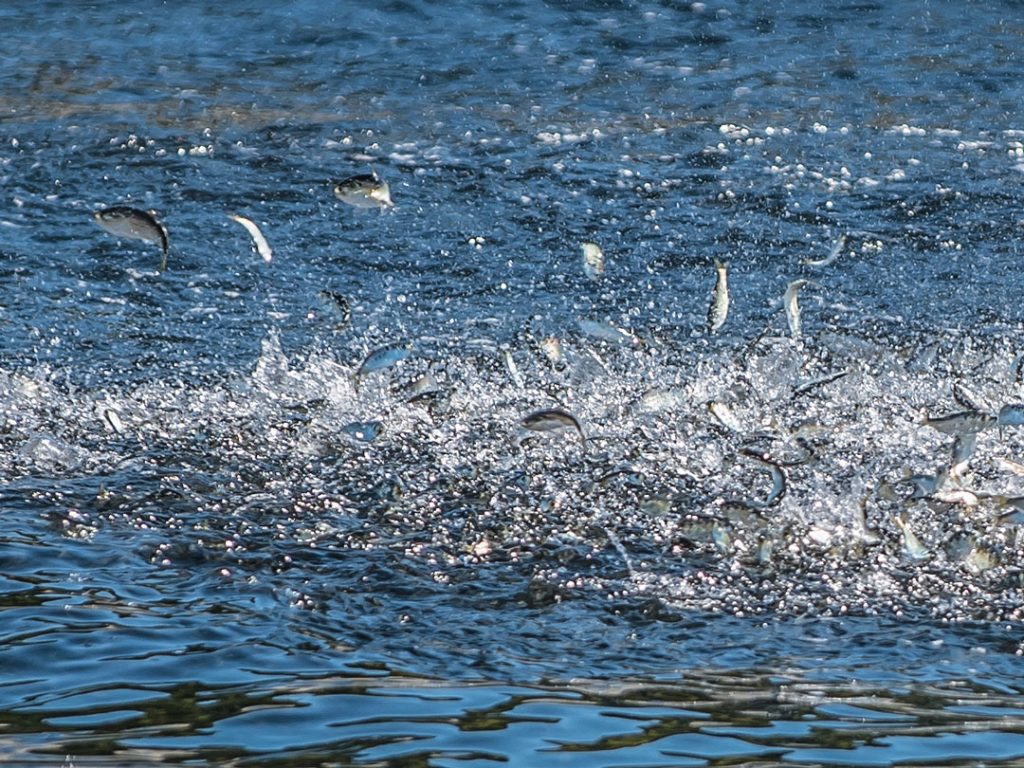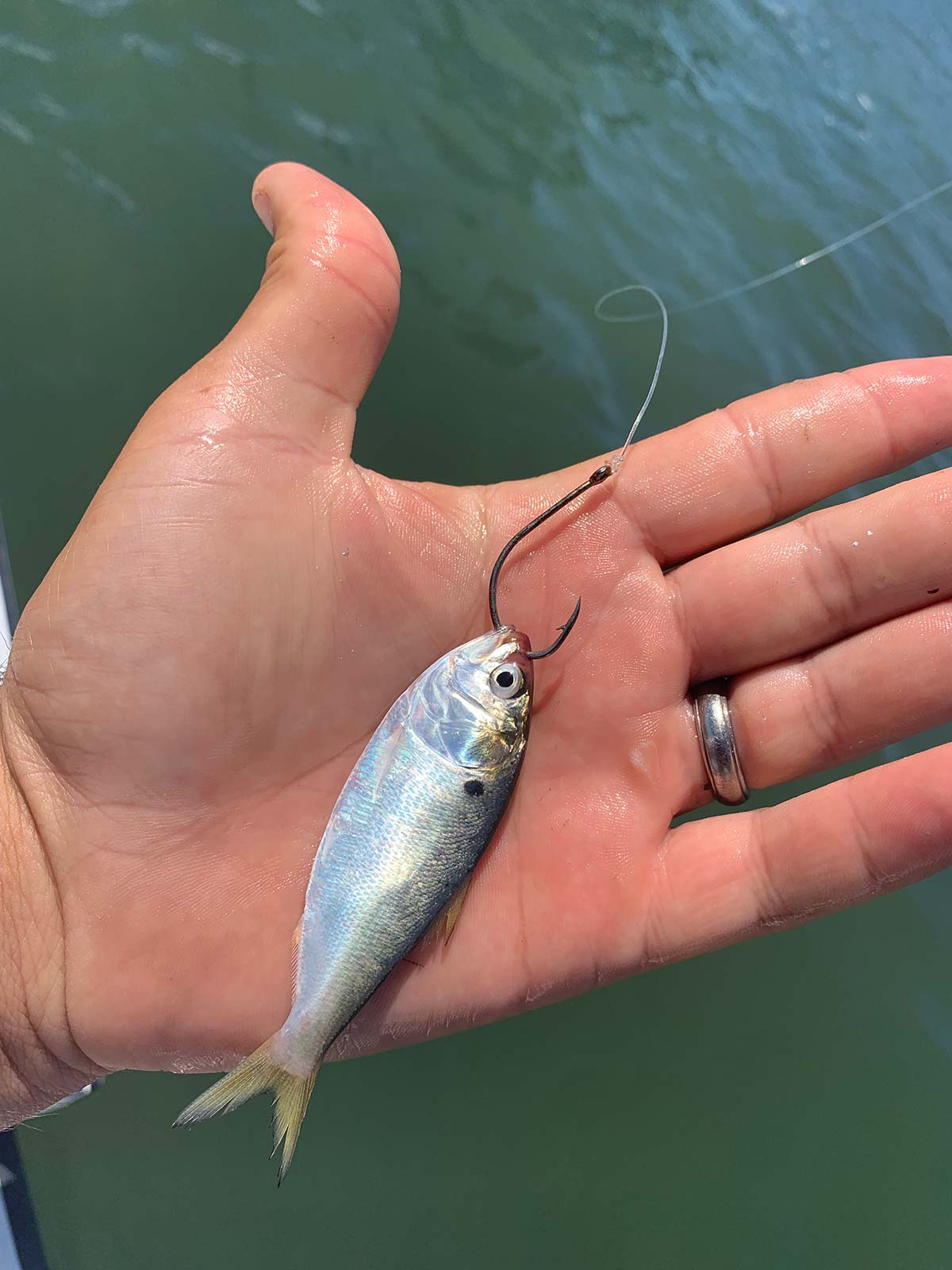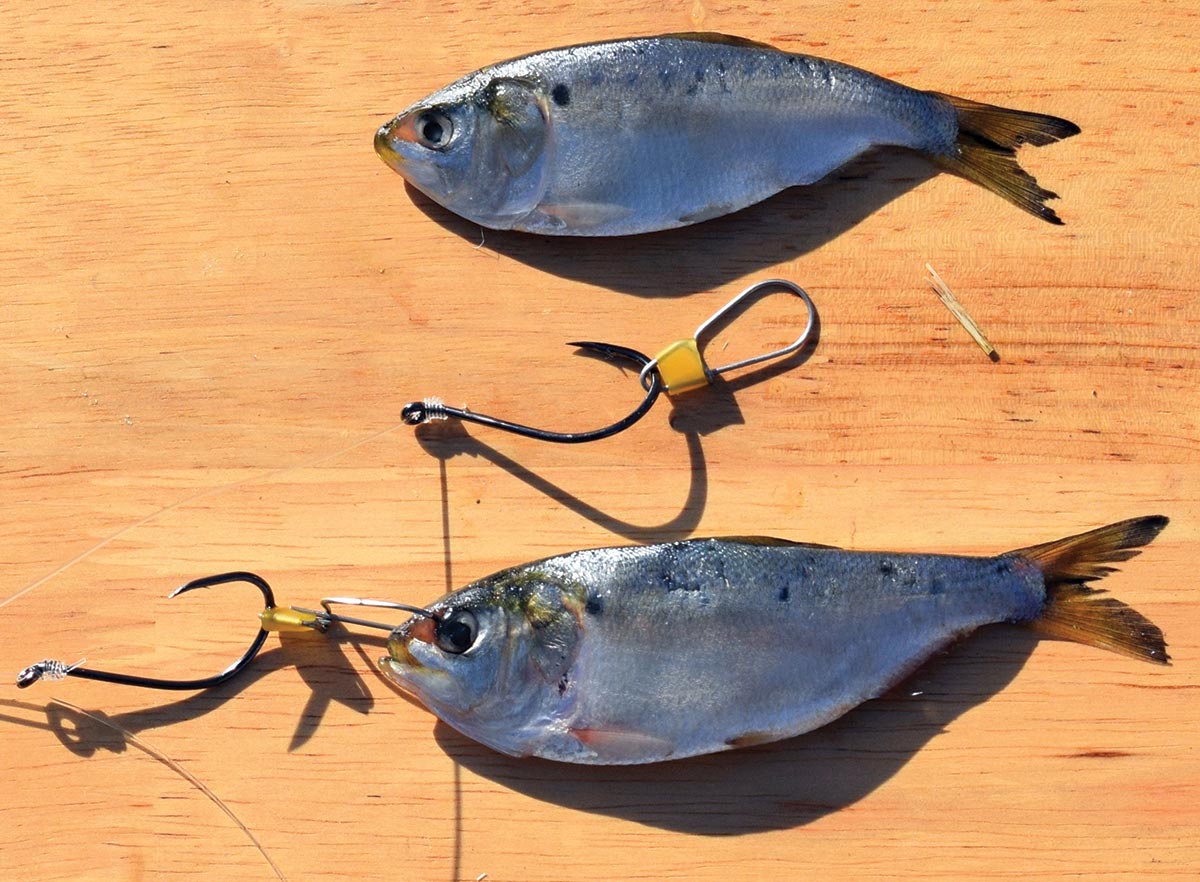
The peanut bunker fish, also known as the Atlantic menhaden, is a small but significant species found along the Atlantic coast of North America. This small fish plays a critical role in the ecosystem and has a profound impact not only on other marine life but also on the economy.
The peanut bunker fish is characterized by its silver color and elongated body shape. They can grow up to 15 inches long and weigh around 1 pound. These fish have a lifespan of about 8 years and can reproduce rapidly, laying thousands of eggs at a time. Their rapid reproduction ensures a consistent population and availability for their predators.
One of the most crucial aspects of the peanut bunker fish is its role as a forage species. They serve as a staple food source for various predatory fish, such as striped bass, bluefish, and weakfish. These larger fish rely heavily on peanut bunker as their primary food source, and depletion of the peanut bunker population can have detrimental effects on the entire food chain.
Furthermore, the peanut bunker fish plays a significant role in the fishing industry. They are widely used as bait for recreational and commercial fishing due to their abundance and effectiveness in attracting larger fish. Additionally, these fish are harvested for their oil, which is used in various industries, including cosmetics and dietary supplements.
In conclusion, the peanut bunker fish is a vital species in the Atlantic coast ecosystem. Its abundance and role as a forage species contribute to the overall health and balance of the marine environment. Moreover, its economic importance and various uses make it a valuable resource for both the fishing industry and other sectors. Understanding and protecting the peanut bunker fish is crucial for ensuring the sustainability of the Atlantic coast ecosystem and the industries it supports.
All You Need to Know About Peanut Bunker Fish
The peanut bunker fish, also known as menhaden or alewife, is a small, silvery fish commonly found in the coastal waters of the Atlantic Ocean and the Gulf of Mexico. These fish are an important part of marine ecosystems and play a crucial role in the food chain.
Habitat and Distribution
Peanut bunker fish prefer brackish and saltwater habitats, such as estuaries, bays, and nearshore waters. They typically inhabit shallow coastal areas with abundant vegetation and oxygen-rich waters. These fish can be found along the eastern coast of North America, from Canada to Florida.
During their annual migration, peanut bunker fish move in large schools along the coastline, providing a significant food source for predators such as striped bass, bluefish, and seabirds.
Importance in the Ecosystem
Peanut bunker fish serve as a vital link in the marine food web. They consume plankton and other microscopic organisms, which helps regulate their populations and maintain water quality. Additionally, they are a primary source of food for many predatory species, including game fish, marine mammals, and seabirds.
Their abundance and availability make peanut bunker fish a valuable bait fish for recreational and commercial fishing. Their oily flesh is also used for fish oil, fishmeal, and other industrial purposes.
Fun Fact: Peanut bunker fish got their name from their resemblance to the size and shape of peanuts.
To summarize, peanut bunker fish are small, silvery fish that inhabit coastal waters. They are an essential part of marine ecosystems, providing food for predators and helping maintain water quality. Their economic value as bait fish and industrial use further highlights their significance.
Interesting Facts about Peanut Bunker Fish
Here are some intriguing facts about peanut bunker fish:
| 1. | Scientific Name: | Menhaden |
| 2. | Size: | Peanut bunker fish are usually about 2.5 to 4 inches long. |
| 3. | Feeding: | They primarily feed on phytoplankton and their high-fat content makes them an important food source. |
| 4. | Habitat: | Peanut bunker fish can be found in coastal Atlantic and Gulf of Mexico waters. |
| 5. | Importance: | They play a vital role in the marine food chain as a prey species for larger predators such as striped bass and bluefish. |
| 6. | Spawning: | They spawn in offshore waters during the spring and summer months. |
| 7. | Other Names: | Peanut bunker fish are also known as Atlantic menhaden, pogy, or mossbunker. |
| 8. | Commercial Value: | Peanut bunker fish are commercially harvested for various purposes including bait for fishing and as a source of fish oil and fish meal. |
These interesting facts highlight the significance of peanut bunker fish in marine ecosystems and their value to both predators and humans.
Habitat of Peanut Bunker Fish
The peanut bunker fish, also known as Menhaden, can be found along the Atlantic coast of North America, from Nova Scotia to Florida. They are commonly found in estuaries, bays, and coastal waters, preferring areas with sandy or muddy bottoms. These fish are known to form large schools, sometimes consisting of thousands of individuals.
Peanut bunker fish are highly adaptable and can tolerate a variety of salinity levels, but they thrive in brackish waters where freshwater from rivers mixes with saltwater from the ocean. They are also capable of surviving in both warm and cool water temperatures, making them highly resilient to changing environmental conditions.
These fish are filter feeders and primarily consume plankton, which they filter out of the water using their gill rakers. They are an important part of the aquatic food chain, serving as a vital food source for larger predatory fish, birds, and marine mammals.
In recent years, peanut bunker fish populations have fluctuated due to various factors, including overfishing, pollution, and habitat degradation. Efforts are being made to manage and protect their populations to ensure the continued health of coastal ecosystems.
Importance of Peanut Bunker Fish in the Ecosystem

Peanut bunker fish, also known as menhaden, play a crucial role in the ecosystem. They are a small species of fish that are found in the coastal waters of the Atlantic Ocean. Despite their size, they have a significant impact on marine life and the overall balance of the ecosystem.
One of the primary roles of peanut bunker fish is their contribution to the food chain. They serve as an important source of food for larger predatory fish, such as striped bass, bluefish, and tuna. These larger fish rely on the abundance of peanut bunker fish to meet their nutritional needs and maintain their populations.
In addition to being a vital food source for larger fish, peanut bunker fish also play a crucial role in filtering the water. They are filter feeders, meaning they consume microscopic plankton and algae that are suspended in the water. By doing so, they help maintain the water quality by reducing excessive nutrient levels and promoting clearer waters.
Peanut bunker fish also contribute to the health and growth of marine plants, such as seagrasses and algae. Their droppings, known as fish feces, serve as natural fertilizers that provide essential nutrients for these plants to thrive. The presence of healthy marine plants is essential for maintaining a balanced ecosystem, as they provide habitats and oxygen for many marine species.
Furthermore, peanut bunker fish are important in the local economy and commercial fishing industry. They are commercially harvested for various purposes, including bait for recreational fishing and as a valuable source of omega-3 fatty acids for dietary supplements and animal feed. The sustainable management of peanut bunker fish populations is crucial to ensure the long-term viability of the fishing industry and the economic well-being of coastal communities.
| Importance of Peanut Bunker Fish in the Ecosystem: |
|---|
| 1. Crucial food source for larger predatory fish |
| 2. Filters water by consuming microscopic plankton and algae |
| 3. Contributes to the health and growth of marine plants |
| 4. Essential for the local economy and commercial fishing industry |
Nutritional Value of Peanut Bunker Fish

Peanut bunker fish, also known as menhaden fish, are not only important in the ecosystem but also a valuable source of nutrition. These small fish are packed with essential nutrients that are beneficial for human health.
One of the key nutritional benefits of peanut bunker fish is their high omega-3 fatty acid content. Omega-3 fatty acids are essential fats that play a crucial role in brain function and heart health. Consuming omega-3 fatty acids can help reduce the risk of heart disease, lower blood pressure, and improve overall brain health.
In addition to omega-3 fatty acids, peanut bunker fish are also a good source of protein. Protein is necessary for building and repairing tissues in the body and plays a vital role in the growth and development of muscles, bones, and organs.
Peanut bunker fish are also rich in vitamins and minerals, including vitamin D, vitamin B12, phosphorus, and selenium. Vitamin D plays a crucial role in bone health, while vitamin B12 is essential for red blood cell production and nervous system function. Phosphorus is important for energy production and maintaining healthy bones and teeth, while selenium acts as an antioxidant and supports a healthy immune system.
Overall, adding peanut bunker fish to your diet can provide you with a wide range of essential nutrients that can contribute to your overall health and well-being.
| Nutrient | Amount per 100g |
|---|---|
| Protein | 20g |
| Omega-3 Fatty Acids | 1.5g |
| Vitamin D | 10mcg |
| Vitamin B12 | 3mcg |
| Phosphorus | 250mg |
| Selenium | 40mcg |
Threats and Conservation Efforts for Peanut Bunker Fish
Peanut bunker fish are facing several threats to their population and habitat. Pollution from industrial and agricultural activities can contaminate the water they live in and harm their health. Chemical pollutants like pesticides and fertilizers can find their way into the waterways, causing the quality of the water to deteriorate. This can lead to the destruction of essential habitats for peanut bunker fish, as well as the degradation of their food sources.
Overfishing is another significant threat to peanut bunker fish. They are often caught in large numbers for bait or processed into industrial products like fish oil and fishmeal. The excessive fishing pressure can lead to the depletion of their populations, disrupting the ecological balance of the marine ecosystem they are a part of.
The loss and degradation of coastal habitats also pose a threat to peanut bunker fish. Coastal development projects, such as the construction of marinas, ports, and residential areas, can result in the destruction of their spawning grounds and nurseries. Coastal habitats are crucial for the reproduction and survival of peanut bunker fish, and their loss can have severe consequences for their population numbers.
Conservation efforts are underway to mitigate the threats faced by peanut bunker fish. Regulatory measures, such as fishing quotas and restrictions, are being implemented to prevent overfishing and help maintain healthy population levels. The establishment of marine protected areas and sanctuaries can also provide refuge and protection for peanut bunker fish and their habitats.
Efforts are also being made to reduce pollution in waterways. Stricter regulations for industrial and agricultural activities help minimize the release of harmful pollutants into the environment. Public awareness campaigns and educational programs aim to promote sustainable practices and raise awareness about the importance of clean water for peanut bunker fish and other aquatic species.
Coastal habitat restoration projects are being undertaken to create and enhance the habitats necessary for the survival of peanut bunker fish. These projects involve the removal of invasive species, the planting of native vegetation, and the construction of artificial structures like oyster reefs and submerged aquatic vegetation beds.
Overall, the conservation efforts for peanut bunker fish are aimed at preserving their population numbers, protecting their habitats, and ensuring their long-term survival. It is crucial to recognize the ecological importance of peanut bunker fish and work towards their conservation to maintain the overall health and biodiversity of marine ecosystems.
Q&A:
What is a peanut bunker fish?
A peanut bunker fish is a type of small bait fish that is a member of the herring family. They are commonly found in estuaries and coastal waters.
Where can peanut bunker fish be found?
Peanut bunker fish can be found along the Atlantic coast of North America, from Florida up to Maine. They are especially abundant in estuaries and bays.
What is the importance of peanut bunker fish?
Peanut bunker fish play an important role in the marine ecosystem as a food source for larger predatory fish and birds. They also serve as a key indicator species for the health of coastal habitats.
How do peanut bunker fish reproduce?
Peanut bunker fish reproduce by releasing their eggs into the water. The eggs then hatch and the young fish grow rapidly, reaching maturity within a few months. They can spawn multiple times in a year.